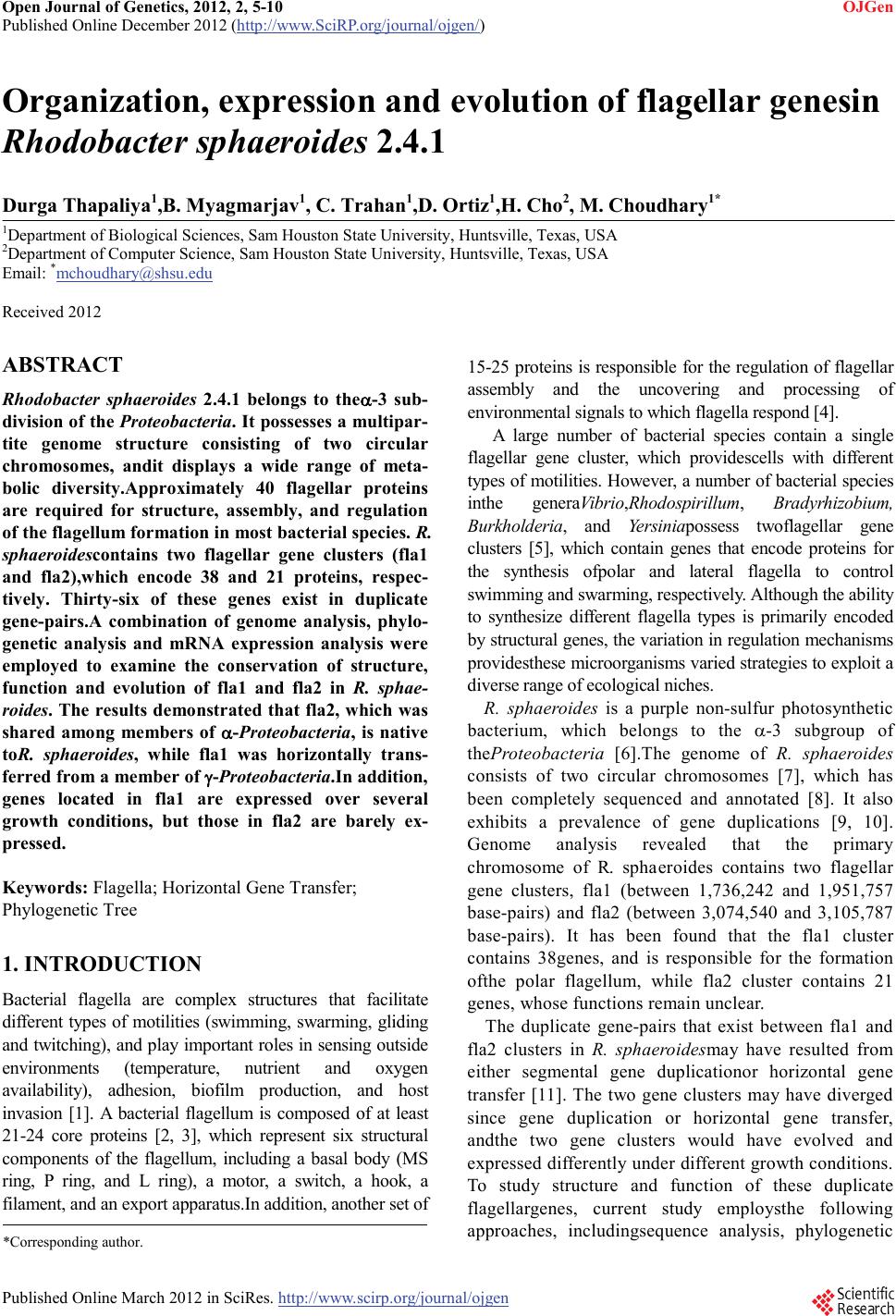
Open Journal of Genetics, 2012, 2, 5-10 OJGen
Published Online December 2012 (http://www.SciRP.org/journal/ojgen/)
Published Online March 2012 in SciRes. http://www.scirp.org/journal/ojgen
Organization, expression and evolution of flagellar genesin
Rhodobacter sphaeroides 2.4.1
Durga Thapaliya1,B. Myagmarjav1, C. Trahan1,D. Ortiz1,H. Cho2, M. Choudhary1*
1Department of Biological Sciences, Sam Houston State University, Huntsville, Texas, USA
2Department of Computer Science, Sam Houston State University, Huntsville, Texas, USA
Email: *mchoudhary@shsu.edu
Received 2012
ABSTRACT
Rhodobacter sphaeroides 2.4.1 belongs to theα-3 sub-
division of the Proteobacteria. It possesses a multipar-
tite genome structure consisting of two circular
chromosomes, andit displays a wide range of meta-
bolic diversity.Approximately 40 flagellar proteins
are required for structure, assembly, and regulation
of the flagellum formation in most bacterial species. R.
sphaeroidescontains two flagellar gene clusters (fla1
and fla2),which encode 38 and 21 proteins, respec-
tively. Thirty-six of these genes exist in duplicate
gene-pairs.A combination of genome analysis, phylo-
genetic analysis and mRNA expression analysis were
employed to examine the conservation of structure,
function and evolution of fla1 and fla2 in R. sphae-
roides. The results demonstrated that fla2, which was
shared among members of α-Proteobacteria, is native
toR. sphaeroides, while fla1 was horizontally trans-
ferred from a member of γ-Proteobacteria.In addition,
genes located in fla1 are expressed over several
growth conditions, but those in fla2 are barely ex-
presse d.
Keywords: Flagella; Horizontal Gene Transfer;
Phylogenetic Tree
1. INTRODUCTION
Bacterial flagella are complex structures that facilitate
different types of motilities (swimming, swarming, gliding
and twitching), and play important roles in sensing outside
environments (temperature, nutrient and oxygen
availability), adhesion, biofilm production, and host
invasion [1]. A bacterial flagellum is composed of at least
21-24 core proteins [2, 3], which represent six structural
components of the flagellum, including a basal body (MS
ring, P ring, and L ring), a motor, a switch, a hook, a
filament, and an export apparatus.In addition, another set of
15-25 proteins is responsible for the regulation of flagellar
assembly and the uncovering and processing of
environmental signals to which flagella respond [4].
A large number of bacterial species contain a single
flagellar gene cluster, which providescells with different
types of motilities. However, a number of bacterial species
inthe generaVibrio,Rhodospirillum, Bradyrhizobium,
Burkholderia, and Yersiniapossess twoflagellar gene
clusters [5], which contain genes that encode proteins for
the synthesis ofpolar and lateral flagella to control
swimming and swarming, respectively. Although the ability
to synthesize different flagella types is primarily encoded
by structural genes, the variation in regulation mechanisms
providesthese microorganisms varied strategies to exploit a
diverse range of ecological niches.
R. sphaeroides is a purple non-sulfur photo synt hetic
bacterium, which belongs to the α-3 subgroup of
theProteobacteria [6].The genome of R. sphaeroides
consists of two circular chromosomes [7], which has
been completely sequenced and annotated [8]. It also
exhibits a prevalence of gene duplications [9, 10].
Genome analysis revealed that the primary
chromosome of R. sphaeroides contains two flagellar
gene clusters, fla1 (between 1,736,242 and 1,951,757
base-pairs) and fla2 (between 3,074,540 and 3,105,787
base-pairs). It has been found that the fla1 cluster
contains 38genes, and is responsible for the formation
ofthe polar flagellum, while fla2 cluster contains 21
genes, whose functions remain unclear.
The duplicate gene-pairs that exist between fla1 and
fla2 clusters in R. sphaeroidesmay have resulted from
either segmental gene duplicationor horizontal gene
transfer [11]. The two gene clusters may have diverged
since gene duplication or horizontal gene transfer,
andthe two gene clusters would have evolved and
expressed differently under different growth conditions.
To study structure and function of these duplicate
flagellargenes, current study employsthe following
approaches, includingsequence analysis, phylogenetic
*Corresponding author.